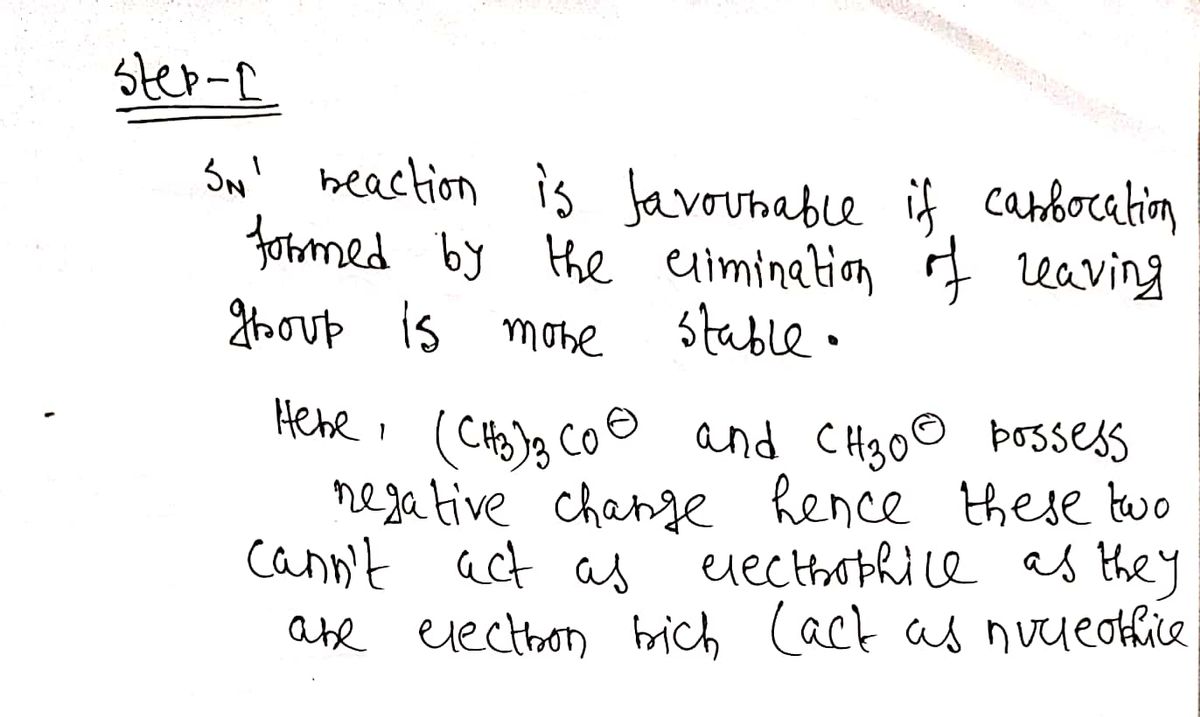Chemistry
10th Edition
ISBN:9781305957404
Author:Steven S. Zumdahl, Susan A. Zumdahl, Donald J. DeCoste
Publisher:Steven S. Zumdahl, Susan A. Zumdahl, Donald J. DeCoste
Chapter1: Chemical Foundations
Section: Chapter Questions
Problem 1RQ: Define and explain the differences between the following terms. a. law and theory b. theory and...
Related questions
Question
help?

Transcribed Image Text:**Which of these would be the best electrophile for an S<sub>N</sub>1 reaction?**
A) CH<sub>3</sub>Br
B) (CH<sub>3</sub>)<sub>3</sub>CBr
C) (CH<sub>3</sub>)<sub>3</sub>CO<sup>−</sup>
D) CH<sub>3</sub>O<sup>−</sup>
*Explanation:*
In an S<sub>N</sub>1 reaction, the best electrophile is one that can form a stable carbocation. Typically, tertiary carbocations are more stable than secondary or primary ones due to hyperconjugation and inductive effects.
- **Option A (CH<sub>3</sub>Br)**: Methyl bromide forms an unstable methyl cation.
- **Option B ((CH<sub>3</sub>)<sub>3</sub>CBr)**: Tertiary butyl bromide forms a stable tertiary carbocation.
- **Option C ((CH<sub>3</sub>)<sub>3</sub>CO<sup>−</sup>)**: Presents as a negative ion, not suitable as an electrophile.
- **Option D (CH<sub>3</sub>O<sup>−</sup>)**: Also a negative ion, unsuitable as an electrophile.
Thus, the best choice for an S<sub>N</sub>1 reaction is **Option B** - (CH<sub>3</sub>)<sub>3</sub>CBr.
Expert Solution
Step 1

Step by step
Solved in 2 steps with 2 images

Recommended textbooks for you

Chemistry
Chemistry
ISBN:
9781305957404
Author:
Steven S. Zumdahl, Susan A. Zumdahl, Donald J. DeCoste
Publisher:
Cengage Learning

Chemistry
Chemistry
ISBN:
9781259911156
Author:
Raymond Chang Dr., Jason Overby Professor
Publisher:
McGraw-Hill Education

Principles of Instrumental Analysis
Chemistry
ISBN:
9781305577213
Author:
Douglas A. Skoog, F. James Holler, Stanley R. Crouch
Publisher:
Cengage Learning

Chemistry
Chemistry
ISBN:
9781305957404
Author:
Steven S. Zumdahl, Susan A. Zumdahl, Donald J. DeCoste
Publisher:
Cengage Learning

Chemistry
Chemistry
ISBN:
9781259911156
Author:
Raymond Chang Dr., Jason Overby Professor
Publisher:
McGraw-Hill Education

Principles of Instrumental Analysis
Chemistry
ISBN:
9781305577213
Author:
Douglas A. Skoog, F. James Holler, Stanley R. Crouch
Publisher:
Cengage Learning

Organic Chemistry
Chemistry
ISBN:
9780078021558
Author:
Janice Gorzynski Smith Dr.
Publisher:
McGraw-Hill Education

Chemistry: Principles and Reactions
Chemistry
ISBN:
9781305079373
Author:
William L. Masterton, Cecile N. Hurley
Publisher:
Cengage Learning

Elementary Principles of Chemical Processes, Bind…
Chemistry
ISBN:
9781118431221
Author:
Richard M. Felder, Ronald W. Rousseau, Lisa G. Bullard
Publisher:
WILEY